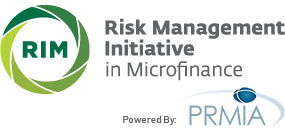Financial and Social Goals
The roof of the Risk Management Graduation Model represents the achievement of an MFI’s financial and social goals. It is essential to bear in mind that the responsibility for reaching these financial and social goal lies on the MFI’s board and senior management and is not part of the risk management function. Accordingly, an MFI’s performance should remain independent from its risk management function in terms of ownership of risk, responsibility, recommendations, and decision-making. Nevertheless, the risk management function should include financial and social performance indicators in its risk reporting to ensure that the board and senior management are conducting systematic monitoring, including monitoring for adherence to key financial and social goals within established risk limits.
With regard to financial and social goal reporting, the risk management function should include the following indicators:
- Social Results – an MFI’s capacity to stay true to its social mission and attain its social goals
- Profitability – an MFI’s capacity to maintain or increase its current level of capital adequacy and attract new investors and shareholders while achieving its social goals
- Efficiency and Productivity – an MFI’s ability to achieve its goals in a cost-efficient manner.
Social Results
Policies
Limits
Tier 3 Guidelines |
Tier 2 Guidelines |
Tier 1 Guidelines |
| Limits for the social objectives identified in the mission: | Limits for the social objectives identified in the mission: | Limits for the social objectives identified in the mission: |
| • “Whom” | • “Whom” | • “Whom” |
| • “How” | • “How” | • “How” |
| • “For what” | • “For what” | • “For what” |
| Number of clients receiving financial education | Number of clients receiving financial education | Number of clients receiving financial education |
Risk Management Tools
Tier 3 Guidelines |
Tier 2 Guidelines |
Tier 1 Guidelines |
| Not applicable | Not applicable | Not applicable |
Risk Monitoring Tools
Tier 3 Guidelines |
Tier 2 Guidelines |
Tier 1 Guidelines |
| Annual monitoring of social objectives identified in the mission: | Annual monitoring of social objectives identified in the mission: | Annual monitoring of social objectives identified in the mission: |
| • “Whom” | • “Whom” | • “Whom” |
| • “How” | • “How” | • “How” |
| • “For what” | • “For what” | • “For what” |
Profitability
Policies
Tier 3 Guidelines |
Tier 2 Guidelines |
Tier 1 Guidelines |
| Not applicable | Not applicable | Not applicable |
Limits
Risk Management Tools
Tier 3 Guidelines |
Tier 2 Guidelines |
Tier 1 Guidelines |
| Not applicable | Not applicable | Not applicable |
Risk Monitoring Tools
Tier 3 Guidelines |
Tier 2 Guidelines |
Tier 1 Guidelines |
| Monthly monitoring of profitability indicators, including: | Monthly monitoring of profitability indicators, including: | Monthly monitoring of profitability indicators, including: |
| • ROE | • ROE | • ROE |
| • ROA | • ROA | • ROA |
| • Trend analysis | • Trend analysis | • Trend analysis |
| • Compared to limits | • Compared to limits | • Compared to limits and projections |
| • Stress-testing | ||
| • OSS | ||
| Monthly monitoring of net portfolio over total assets, or unproductive assets over total assets | Monthly monitoring of net portfolio over total assets, or unproductive assets over total assets |
Efficiency and Productivity
Policies
Tier 3 Guidelines |
Tier 2 Guidelines |
Tier 1 Guidelines |
| Not applicable | Not applicable | Not applicable |
Limits
Tier 3 Guidelines |
Tier 2 Guidelines |
Tier 1 Guidelines |
| Limits for efficiency and productivity indicators: | Limits for efficiency and productivity indicators: | Limits for efficiency and productivity indicators: |
| • Loan officer productivity (borrowers) | • Loan officer productivity (borrowers) | • Loan officer productivity (borrowers and gross portfolio) |
| • Operating expenses over gross portfolio | • Operating expenses over gross portfolio | • Operating expenses over gross portfolio |
| • Operating expenses over total assets | • Operating expenses over total assets | |
| • Cost per borrower | • Cost per borrower | |
| • Staff productivity (borrowers and gross portfolio) |
Risk Management Tools
Tier 3 Guidelines |
Tier 2 Guidelines |
Tier 1 Guidelines |
| Not applicable | Not applicable | Not applicable |
Risk Monitoring Tools
Tier 3 Guidelines |
Tier 2 Guidelines |
Tier 1 Guidelines |
| Monthly monitoring of efficiency and productivity indicators, including: | Monthly monitoring of efficiency and productivity indicators, including: | Monthly monitoring of efficiency and productivity indicators, including: |
| • Trend analysis | • Trend analysis | • Trend analysis |
| • Compared to limits | • Compared to limits | • Compared to limits |
| • Operating expenses over gross portfolio | • Operating expenses over gross portfolio | • Operating expenses over gross portfolio |
| • Loan officer productivity (borrowers) | • Loan officer productivity (borrowers) | • Loan officer productivity (borrowers and gross portfolio) |
| • Operating expenses over total assets | • Operating expenses over total assets | |
| • Cost per borrower | • Cost per borrower | |
| • Staff productivity (borrowers and gross portfolio) |
Evaluate
